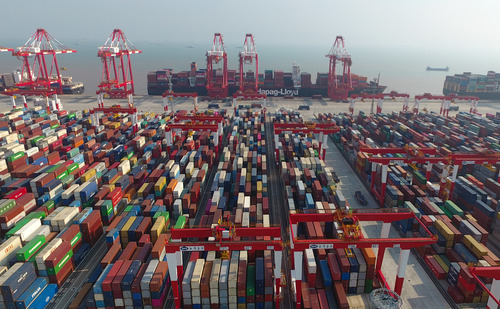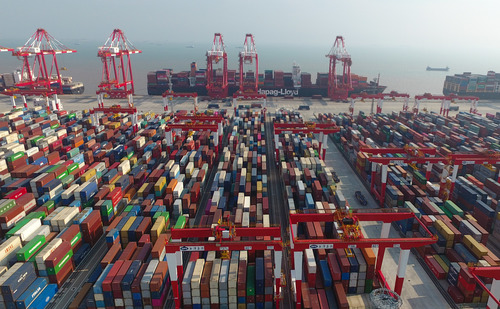
BEIJING, Aug. 13 (Xinhua) – In spite of the stringent and complicated external situations, Chinese exporters are expected to source orders from rigid or inelastic overseas demand and alternative demand in the second half of this year after July trade recovered further, said experts.
Last month, China's foreign trade continued to pick up after posting positive year-on-year growths in June, up 6.5 percent to 2.93 trillion yuan, with imports up 1.6 percent to 1.24 trillion yuan and exports up 10.4 percent to 1.69 trillion yuan.
While enterprises are trying hard to acquire orders and focus on the domestic market, China will continue to support them in market exploration in an all-around manner in order to stabilize the base of foreign trade.
-- Electromechanical and IC products deemed the driving force
From January to July, China's total import and export valued 17.16 trillion yuan, down by 1.7 percent year on year and 1.5 percentage points lower than the comparable decline in the first six months, showed statistics from the Generation Administration of Customs (GAC). Exports amounted to 9.4 trillion yuan and imports were 7.76 trillion yuan, down by 0.9 percent and 2.6 percent respectively.
The main products that drove exports were automatic data processing equipment, masks and other textile products, plastic products, and integrated circuit (IC), said Shi Xianjin, associate researcher with Institute of World Economics and Politics under Chinese Academy of Social Sciences.
During the first seven months of this year, China's electromechanical product exports ticked up 0.2 percent year on year to 5.5 trillion yuan, accounting for 58.5 percent of the country's total export value. As Shi held, the greatest contributor was automatic data processing equipment and its components. Their exports grew 16.1 percent year on year in June and 35.7 percent in July, making up 8.1 percent of the total July export and representing an export growth contribution rate of 31.3 percent.
Moreover, masks and other textile products remained a driving force of export. The export of masks and other textiles amounted to 634.32 billion yuan in the first 7 months of the year, up by 35.8 percent year on year.
What's noteworthy is that IC products also had a high export contribution rate in July. As Shi calculated, its year-on-year growth rate increased from 8.4 percent in June to 15.9 percent in July , taking up 4.5 percent of the total exports in July.
In the future, exports of quality IC products are highly anticipated as the State Council, the Chinese cabinet, issued a document early in August proposing to deepen global cooperation in IC industry and software industry and promote the exports in IC industry and software industry.
-- Resumption of production guarantees supply capacity
It is notable that the decline in imports and exports narrowed in the first 7 months of the year. The double-digit growth in exports in July and positive growths in imports since June are laudable achievement indeed even compared with the same periods of 2019.
Experts attributed the narrowed January-July foreign trade decline mainly to resumed enterprise production and operation since May, which provided sufficient production capacities and backed up recovery of exports.
China's supply advantages and resumption of production overseas have jointly contributed to the gradual recovery of export orders if taking into consideration of high-frequency data such as flights with North America and Europe and cargo throughput at main ports in China, noted Li Chao, chief economist with Zheshang Securities.
In early and mid July, cargo throughput of main hub ports in China grew by 12.1 percent and seven percent year on year and international cargo throughput rose by 14.4 percent and 6.4 percent year on year respectively, introduced Li.
-- Inelastic external demands back up new orders
The exuberant July imports and exports marked a good opening for China's foreign trade in the second half of this year, but will the uptrend of import and export continue in future?
In the second half of 2020, foreign trade conditions will still be closely related to global pandemic prevention and control. The reoccurrence of the pandemic and decline in external market demands may affect China's foreign trade, said Pang Chaoran, associate researcher with Chinese Academy of International Trade and Economic Cooperation (CAITEC).
However, the good news is that the previous policies to support resumption of production and stabilize foreign trade are expected to exert strong guarantee to the sustainable and healthy development of foreign trade in the second half of the year, added Pang.
Where will new orders come from in the future? According to Bai Ming, deputy director of CAITEC's international market research department, many inventory orders were delivered in June and the future orders will mainly come from rigid or inelastic overseas demands and alternative exports as industrial chains of other countries are disrupted and Chinese goods will become a substitute in time.
In Bai's opinion, export-oriented enteprises are not likely to see orders as few as in March and April this year as they may turn back to explore demand in the domestic market. (Edited by Duan Jing with Xinhua Silk Road, duanjing@xinhua.org)




 A single purchase
A single purchase









